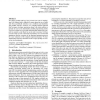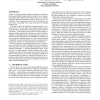PPOPP
2012
ACM
13 years 2 months ago
2012
ACM
We present Dynamic Out-of-Order Java (DOJ), a dynamic parallelization approach. In DOJ, a developer annotates code blocks as tasks to decouple these blocks from the parent executi...
PPOPP
2011
ACM
13 years 10 months ago
2011
ACM
Developing parallel software using current tools can be challenging. Even experts find it difficult to reason about the use of locks and often accidentally introduce race condit...
SAS
2010
Springer
14 years 5 months ago
2010
Springer
Proving termination of sequential programs is an important problem, both for establishing the total correctness of systems and as a component of proving more general termination an...
JAR
2008
14 years 7 months ago
2008
We analyze three proof strategies commonly used in deductive verification of deterministic sequential programs formalized with operational semantics. The strategies are: (i) stepw...
ICPPW
2002
IEEE
15 years 5 days ago
2002
IEEE
The aim of this work is to provide a high performance air quality simulation using the STEM-II (Sulphur Transport Eulerian Model 2) program. First of all we optimize the sequentia...
CF
2010
ACM
15 years 9 days ago
2010
ACM
Competitive parallel execution (CPE) is a simple yet attractive technique to improve the performance of sequential programs on multi-core and multi-processor systems. A sequential...
ISCA
2003
IEEE
15 years 15 days ago
2003
IEEE
We describe the Java runtime parallelizing machine (Jrpm), a complete system for parallelizing sequential programs automatically. Jrpm is based on a chip multiprocessor (CMP) with...
PLDI
2004
ACM
15 years 20 days ago
2004
ACM
The design of concurrent programs is error-prone due to the interaction between concurrently executing threads. Traditional automated techniques for finding errors in concurrent ...
OOPSLA
2005
Springer
15 years 22 days ago
2005
Springer
is a simple and elegant abstraction that allows concurrency to be expressed often through a relatively small rewrite of a sequential program. In the absence of side-effects, futur...
ISCA
2006
IEEE
15 years 1 months ago
2006
IEEE
We present Program Demultiplexing (PD), an execution paradigm that creates concurrency in sequential programs by "demultiplexing" methods (functions or subroutines). Cal...


